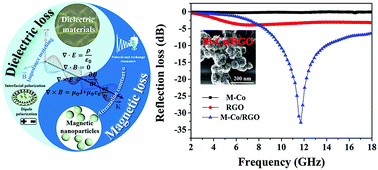Synergistic engineering of dielectric and magnetic losses in M-Co/RGO nanocomposites for use in high-performance microwave absorption†
Abstract
The development of microwave absorption materials with well-matched impedance matching and higher attenuation constants still remains a challenge, and this restricts improvement in their absorption performance. Herein, magnetic cobalt/reduced graphene oxide (M-Co/RGO) nanocomposites with enhanced microwave absorption performance were tailored by utilizing the synergy of impedance matching and attenuation constant based on the strategy of synergistic engineering of dielectric and magnetic losses. The synergistic engineering between the dielectric loss of RGO and the magnetic loss of M-Co nanoparticles enhances the impedance matching and attenuation constant and realizes improved microwave absorption. Through tuning of the mass ratio and filler loading of M-Co/RGO nanocomposites, the impedance matching and attenuation constant can reach 0.95 and 129.6, respectively, and the maximum reflection loss of −32.85 dB is achieved at 11.7 GHz. Furthermore, the tunable effective absorption bandwidth of M-Co/RGO nanocomposites can reach 8 GHz within a thickness of 2.2 mm. The dielectric and magnetic losses of M-Co/RGO nanocomposites primarily originate from dipole polarization, interfacial polarization, and multiple magnetic resonances. Undoubtedly, this strategy for synergistic engineering of dielectric and magnetic losses will provide new insight into the design of high-performance microwave absorbents.



 Please wait while we load your content...
Please wait while we load your content...